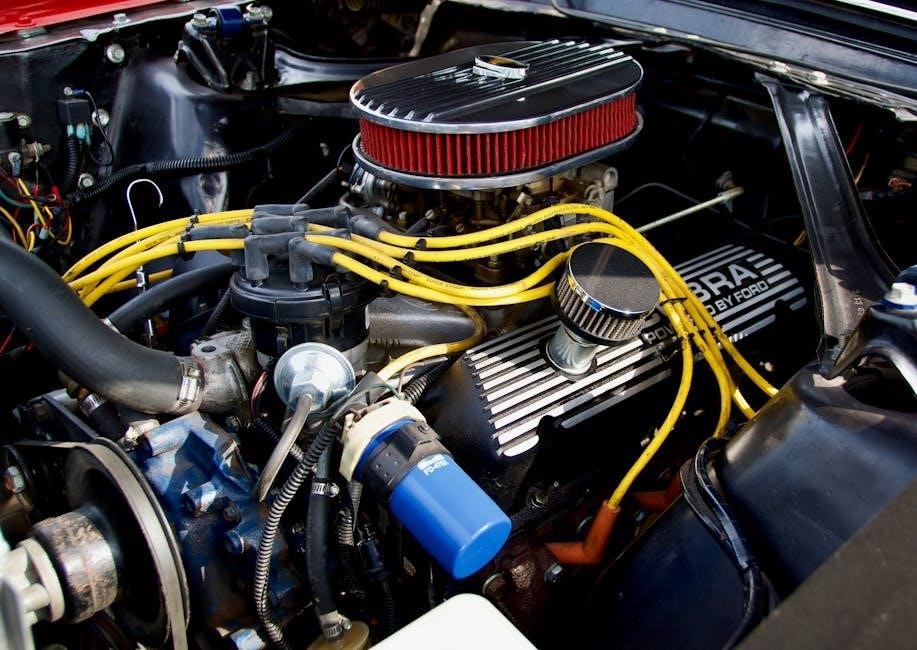Regular maintenance is crucial for extending the lifespan of your Ford F-250. This guide provides essential tips and schedules to keep your truck in optimal condition.
1.1 Importance of Regular Maintenance
Regular maintenance is vital for preventing major repairs, enhancing performance, and ensuring reliability. It helps identify potential issues early, reducing long-term costs and extending the truck’s lifespan. Consistent upkeep also optimizes fuel efficiency and ensures safety on the road, especially for heavy-duty vehicles like the Ford F-250. Adhering to the recommended schedule guarantees peak functionality and avoids unexpected breakdowns.
1.2 Overview of the Ford F-250
The Ford F-250 is a powerful, durable pickup truck designed for heavy-duty tasks. Known for its robust engine options and towing capabilities, it is a popular choice for both work and recreational use. Regular maintenance is essential to uphold its performance and longevity, especially under severe operating conditions. Proper care ensures reliability and sustained functionality over time.

Understanding the Ford F-250 Maintenance Schedule PDF
The Ford F-250 maintenance schedule PDF provides a comprehensive guide for routine and severe-duty care. It outlines essential services, intervals, and recommendations to ensure optimal vehicle performance and longevity.
2.1 What is Included in the Schedule?
The Ford F-250 maintenance schedule PDF includes routine service intervals, severe-duty recommendations, fluid and filter change guidelines, and inspections for critical components. It also covers towing and hauling specifications, ensuring comprehensive care for optimal performance and longevity.
2.2 How to Access the PDF
To access the Ford F-250 maintenance schedule PDF, visit Ford’s official service website. Select your vehicle’s model year and download the owner’s manual or maintenance guide. Additional resources, such as the Ford Service Content website, provide detailed PDFs for specific maintenance needs. Ensure you log in with your Ford account for full access.
2.3 Key Components of the Schedule
The Ford F-250 maintenance schedule PDF outlines essential service intervals, including oil changes, filter replacements, and fluid checks. It also covers tire rotations, brake inspections, and belt replacements. Severe-duty recommendations are included for frequent towing or extreme conditions, ensuring optimal performance and longevity of your vehicle.
Severe Duty Maintenance Recommendations
Severe-duty maintenance is vital for F-250s used in extreme conditions, such as frequent towing or high mileage. Regular fluid and filter changes are essential.
3.1 Towing and Hauling Guidelines
For F-250s used for towing or hauling, follow severe-duty schedules if towing exceeds 30% of usage. Regular fluid changes and filter replacements are critical. Use high-quality fluids to prevent wear. Refer to the Ford F-250 maintenance schedule PDF for specific intervals. Avoid cheap parts to ensure longevity and performance under heavy loads.
3.2 High Mileage and Extreme Conditions
For high-mileage F-250s or those operating in extreme conditions, follow severe-duty maintenance schedules. This includes more frequent fluid changes and inspections. Synthetic oils are recommended for better performance in extreme temperatures. Regularly check belts, hoses, and brakes to prevent premature wear. Refer to the Ford F-250 maintenance schedule PDF for tailored guidelines to ensure longevity.

3.3 Fluid and Filter Requirements
Adhere to the Ford F-250 maintenance schedule PDF for fluid and filter guidelines. Engine oil changes are recommended every 5,000 to 7,500 miles, while transmission fluid should be replaced every 30,000 miles. Coolant and brake fluid inspections are needed every 50,000 miles. Regular filter replacements, including air and fuel filters, ensure optimal performance and prevent contamination. Synthetic oils are suggested for extreme conditions.
Fluids and Filters Maintenance
Regular fluid and filter replacements are vital for your Ford F-250’s performance. Follow the schedule for engine oil, transmission fluid, coolant, and filters to prevent contamination and ensure longevity.
4.1 Engine Oil and Filter Replacement
Regular engine oil and filter changes are essential for your Ford F-250’s performance. The recommended interval is every 5,000 to 7,500 miles under normal conditions. For severe duty, such as frequent towing or extreme temperatures, replace the oil and filter every 5,000 miles. Use synthetic oil for better engine protection and longevity. Always consult your owner’s manual for specific guidelines to avoid premature wear and ensure optimal engine health.
4.2 Transmission Fluid and Filter
Transmission fluid and filter maintenance is vital for smooth gear operation. Replace the transmission fluid every 30,000 miles under normal conditions or every 15,000 miles for severe duty. Use genuine Ford parts to ensure compatibility and optimal performance. Regular fluid changes prevent overheating and extend the lifespan of your Ford F-250’s transmission system.
4.3 Coolant and Brake Fluid
Regular coolant checks prevent overheating, while brake fluid maintenance ensures safe stopping power. Replace coolant every 50,000 to 100,000 miles and brake fluid every 30,000 miles. Use genuine Ford parts for optimal performance. Check for leaks and contamination to avoid system damage. Consult your owner’s manual for specific guidelines tailored to your F-250’s operating conditions.

4.4 Fuel Filter and Injector Cleaning
Replace the fuel filter every 15,000 to 30,000 miles to ensure proper fuel flow. Clean fuel injectors every 30,000 miles to maintain engine efficiency. Use high-quality filters and cleaners to prevent clogs and wear. Regular maintenance helps improve fuel economy and reduces emissions, keeping your F-250 running smoothly under all conditions.

Owner’s Manual Guidance
Your Ford F-250’s owner’s manual provides detailed maintenance schedules and guidelines. It outlines recommended service intervals, special operating conditions, and essential checks to ensure optimal performance and longevity.
5.1 Navigating the Owner’s Manual
The Ford F-250 owner’s manual is organized into clear sections, including maintenance schedules and guidelines. It provides detailed information on service intervals, special operating conditions, and essential checks. Users can easily navigate through chapters to find specific maintenance recommendations, ensuring they stay on track with required services. Online access to the manual offers convenience for quick reference and updates.
5.2 Special Operating Conditions
The owner’s manual outlines special operating conditions, such as frequent towing, hauling heavy loads, or driving in extreme temperatures. These conditions require adjusted maintenance schedules to ensure the truck’s longevity. Owners should pay attention to these guidelines to prevent premature wear and maintain optimal performance under demanding use. Regular checks and fluid changes are emphasized in these scenarios.
5.3 Recommended Maintenance Intervals
The Ford F-250 maintenance schedule outlines specific intervals for services like oil changes, tire rotations, and fluid checks. Typically, these occur every 5,000 to 7,500 miles. Following these intervals ensures optimal performance and prevents potential issues. The owner’s manual provides detailed recommendations tailored to your truck’s usage, helping you stay on track with essential upkeep.

Scheduled Maintenance Intervals
Regular maintenance every 5,000 to 7,500 miles is crucial for your Ford F-250. Follow the schedule in your owner’s manual for optimal performance and longevity.
6.1 Every 5,000 to 7,500 Miles
At this interval, change the engine oil and filter, inspect tire pressure, and check belts and hoses. Ensure all fluids are at recommended levels. If towing frequently, consider more frequent servicing as per severe duty guidelines in your Ford F-250 maintenance schedule PDF.
6.2 Every 15,000 to 30,000 Miles
Replace the engine oil and filter, inspect the air filter, and check the battery terminals. Rotate tires if needed, and inspect belts, hoses, and brakes. For trucks used in severe conditions, consider differential fluid checks. Refer to your Ford F-250 maintenance schedule PDF for detailed recommendations tailored to your usage.
6.3 Every 60,000 to 105,000 Miles
Replace spark plugs for optimal engine performance and inspect drive belts for wear. Check coolant hoses for cracks and brake pads for wear. Lubricate wheel bearings and ensure proper brake function. Refer to your Ford F-250 maintenance schedule PDF for specific recommendations tailored to your vehicle’s age and mileage.
6;4 Every 150,000 Miles and Beyond
At 150,000 miles, perform a thorough inspection of belts, hoses, and coolant systems. Replace the timing belt and water pump if not done earlier. Flush the transmission and coolant, and inspect the rear differential. Refer to your Ford F-250 maintenance schedule PDF for detailed recommendations to ensure long-term reliability and performance.

Special Operating Conditions
Adjust maintenance for extreme conditions like frequent towing, high mileage, or harsh environments. Consult the Ford F-250 maintenance schedule PDF for tailored guidance to ensure durability.
7.1 Towing and Trailer Setup
Proper towing and trailer setup is vital for safety and performance. Always follow Ford F-250 maintenance schedule PDF guidelines for hitch installation and weight limits. Regularly inspect wiring and connections. Ensure brake systems are compatible and functioning. For frequent towing, consider severe-duty maintenance recommendations to prevent wear. Use genuine Ford parts for reliability and longevity.
7.2 Off-Road and Construction Use
Off-road and construction use demands extra maintenance attention. Frequent cleaning of the undercarriage and wheel wells is essential. Check axle and differential fluids regularly. Inspect air filters more often due to dust exposure. Follow the Ford F-250 maintenance schedule PDF for severe-duty intervals. Use genuine Ford parts for durability. Ensure proper tire pressure and inspect suspension components regularly for wear.
7.3 High Mileage and Severe Duty
For high mileage and severe-duty use, follow the Ford F-250 maintenance schedule PDF closely. Increase the frequency of fluid changes, especially engine oil and transmission fluid. Inspect air and fuel filters more often. Check belts, hoses, and brakes for wear. Ensure proper coolant levels and condition. Consult the severe-duty section for specific recommendations to maintain performance and longevity under extreme conditions.
DIY vs. Professional Maintenance
DIY maintenance is cost-effective for routine tasks like oil changes, but complex issues require professional expertise. Always follow the Ford F-250 maintenance schedule PDF guidelines.
8.1 Pros and Cons of DIY Maintenance
DIY maintenance saves money and allows personal oversight, but it requires time and mechanical skills. Improper techniques can void warranties or cause damage, emphasizing the need for adherence to the Ford F-250 maintenance schedule PDF guidelines to ensure reliability and longevity of your vehicle.
8.2 When to Consult a Professional
Consult a professional for complex tasks like transmission flushes or differential services. If unsure about procedures or tools, seeking expert help prevents costly mistakes and ensures adherence to the Ford F-250 maintenance schedule PDF, safeguarding your truck’s performance and warranty.
Common Maintenance Mistakes to Avoid
Neglecting fluid changes, ignoring wear signs, and using incorrect parts are common errors. Adhering to the Ford F-250 maintenance schedule PDF helps prevent these costly oversights.
9.1 Neglecting Fluid Changes
Regular fluid changes are vital for your Ford F-250’s longevity. Neglecting engine oil, transmission, coolant, and brake fluid replacements can lead to premature wear and costly repairs. Always follow the recommended intervals in the Ford F-250 maintenance schedule PDF, especially for severe-duty conditions, to ensure optimal performance and avoid breakdowns.
9.2 Ignoring Wear and Tear Signs
Ignoring wear and tear signs, such as unusual noises or vibrations, can lead to major repairs. Regular inspections and timely replacements are crucial. Follow the Ford F-250 maintenance schedule PDF to identify and address issues early, ensuring your truck remains reliable and performs at its best under all operating conditions.
9.3 Using Incorrect Parts and Fluids
Using incorrect parts and fluids can damage your Ford F-250 and void warranties. Always refer to the maintenance schedule PDF for approved specifications. Incorrect engine oil or transmission fluid can lead to mechanical failure. Ensure all components meet OEM standards for optimal performance and longevity. Consult the manual or a professional to avoid costly repairs.

Importance of Genuine Ford Parts
Genuine Ford parts ensure optimal performance, durability, and compatibility with your F-250. They meet OEM standards, maintaining warranty validity and preventing potential damage from non-approved components.
10.1 Benefits of OEM Parts
Genuine Ford parts are designed to meet strict OEM standards, ensuring proper fitment and performance. They maintain your truck’s warranty and provide long-term durability. Using OEM parts prevents potential issues caused by non-approved components, ensuring reliability and optimal functionality for your F-250.

10.2 Where to Purchase Genuine Parts
Genuine Ford parts can be purchased directly from authorized Ford dealerships or through Ford’s official online store. Additionally, trusted retailers like FordServiceContent.com offer authentic components. Always verify the seller’s authenticity to ensure you receive genuine parts designed for your F-250, maintaining its performance and warranty.
Tracking and Logging Maintenance
Tracking and logging maintenance ensures compliance with schedules and extends vehicle longevity. Use digital tools or a maintenance log to record services, fluids, and parts replaced for accountability.
11.1 Using a Maintenance Log
A maintenance log helps track services, fluids, and parts replaced, ensuring adherence to schedules. It provides a clear record for future reference and can be useful during professional inspections or resale. Regular updates ensure accountability and help identify potential issues early, prolonging your Ford F-250’s longevity and performance over time.
11.2 Digital Tools for Tracking
Digital tools like maintenance apps and online platforms simplify tracking your Ford F-250’s upkeep. They allow you to set reminders, log services, and access your maintenance schedule PDF. These tools help ensure consistency, reduce oversight, and provide a centralized record of your truck’s service history for easy reference and long-term maintenance management.

Cost Estimates for Maintenance
Regular maintenance for a Ford F-250 averages $500-$1,000 annually. Severe-duty schedules may increase costs by 20-30%. Routine services include oil changes, filters, and inspections.
12.1 Routine Maintenance Costs
Routine maintenance for a Ford F-250 typically ranges from $500 to $1,000 annually. This includes oil changes, filter replacements, and inspections. Costs may vary based on mileage and usage conditions. Severe-duty operations can increase expenses by 20-30%. Sticking to the recommended schedule ensures long-term savings and prevents costly repairs down the road.
12.2 Severe Duty Maintenance Costs
Severe-duty maintenance for Ford F-250s can range from $1,200 to $2,500 annually. This includes more frequent fluid changes, transmission flushes, and differential services. Costs increase due to extreme operating conditions like heavy towing or high mileage. Following the severe-duty schedule ensures reliability and minimizes long-term repair expenses.
Adhering to the Ford F-250 maintenance schedule ensures longevity and performance. Follow severe-duty recommendations for heavy use, use genuine parts, and track maintenance to avoid costly repairs.
13.1 Recap of Key Maintenance Points
Regular maintenance is vital for your Ford F-250’s longevity. Follow the recommended schedule, especially for severe-duty conditions. Ensure timely fluid changes, filter replacements, and inspections; Use genuine Ford parts for reliability. Track maintenance logs to stay organized and avoid overlooked services, ensuring your truck performs optimally for years to come.
13;2 Final Tips for Longevity
Adhere to the Ford F-250 maintenance schedule PDF for optimal performance. Monitor fluid levels and tire pressure regularly. Avoid extreme temperatures and rough driving conditions when possible. Invest in genuine Ford parts for critical components. Keep a detailed maintenance log and address issues promptly to ensure your truck remains reliable and durable over the years.
